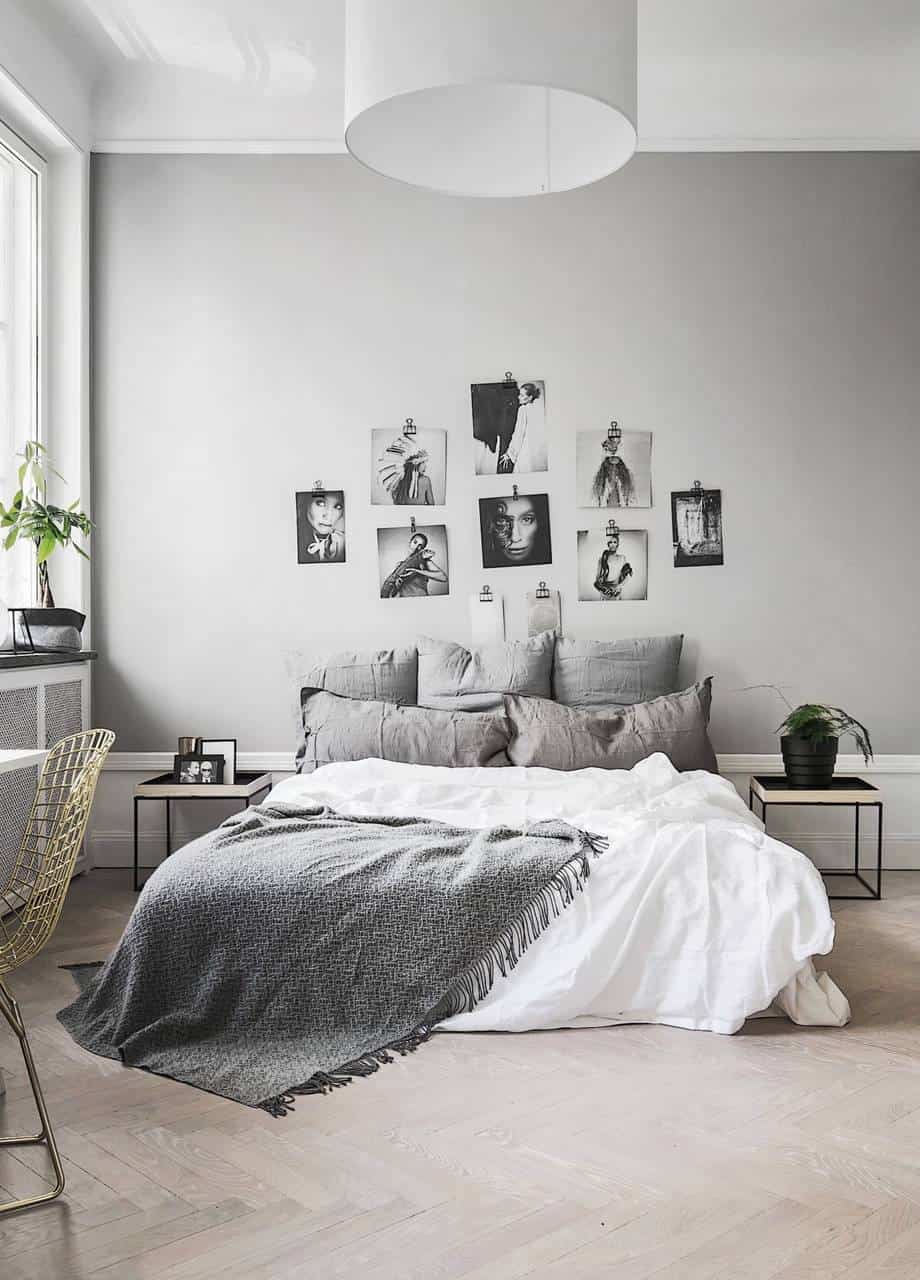A minimalistic bedroom is all about simplicity, clean lines, and creating a peaceful, functional space with fewer but more meaningful elements. Here are some ideas to help you design a minimalistic bedroom that promotes relaxation, organization, and style:
1. Embrace Neutral Colors
Neutral colors are the foundation of a minimalistic bedroom, creating a soothing and serene environment. Lighter shades can help make the space feel more open and airy.
Walls: Opt for light colors like white, soft gray, beige, or muted pastels for your walls. These tones make the room feel spacious and calming.
Bedding: Stick to neutral-toned bedding like white, off-white, light gray, or beige. This simplicity contributes to the minimalist aesthetic and enhances the peaceful vibe.
2. Opt for Simple, Low-Profile Furniture
Minimalistic furniture should have a clean, functional design without excessive ornamentation. Choose pieces that offer practicality and maintain a streamlined look.
Bed: Go for a low-profile platform bed with clean lines. A simple bed frame in wood, metal, or a neutral-colored upholstered bed will maintain an understated, minimalist feel.
Nightstands: Select small, streamlined nightstands with no frills. A floating nightstand or wall-mounted unit can save floor space while maintaining a sleek look.
Storage: Use functional, minimal storage options like floating shelves, hidden storage under the bed, or a small, simple dresser. This helps eliminate clutter and keeps the room feeling open.
3. Declutter the Space
Minimalism is all about reducing excess. Keep the room organized and clutter-free by eliminating unnecessary furniture and décor.
Organize: Only keep essential items in the room. Invest in storage solutions like under-bed drawers or hidden compartments to keep things out of sight and maintain a tidy, spacious feel.
Décor: Limit décor to a few meaningful pieces. A simple plant, a single piece of art, or a cozy throw can provide subtle visual interest without overwhelming the space.
4. Maximize Natural Light
Natural light can make the room feel bigger, brighter, and more inviting. A minimalistic bedroom should make the most of natural light to maintain an open, airy feel.
Windows: Avoid heavy drapes or thick curtains. Instead, opt for light, sheer curtains that allow sunlight to filter through while maintaining privacy.
Mirrors: Incorporating a large, simple mirror can help reflect natural light, making the room feel more spacious and adding visual depth.
5. Incorporate Natural Materials
Using natural materials in the bedroom brings warmth and texture while keeping the design clean and uncluttered.
Wood: A wooden bed frame, nightstand, or floating shelves adds warmth to the room. Light woods like oak or walnut are perfect for creating a calm and grounded feel.
Textiles: Opt for natural fabrics like linen, cotton, or wool for bedding, curtains, and rugs. These materials feel soft and breathable, perfect for a minimalist design.
6. Keep Wall Décor to a Minimum
Wall décor in a minimalist bedroom should be simple and purposeful. Instead of overcrowding the walls, focus on one or two key pieces that add elegance and interest.
Art: Choose a large, simple art piece or a few small prints in neutral tones or abstract designs. Black-and-white photography, minimal line drawings, or geometric patterns work well.
Mirrors: A large mirror with a simple frame can serve as both functional and decorative, reflecting light and making the space feel larger.
7. Use Soft, Subtle Lighting
Lighting is key to creating the right ambiance in a minimalist bedroom. Choose lighting that enhances the calming environment without being too harsh or overpowering.
Bedside Lamps: Choose small, simple bedside lamps that provide soft light. Opt for lamps with sleek, neutral designs that don’t take up too much space.
Floor Lamps: A minimalist floor lamp can add both function and style to the room. Look for one with clean lines and an adjustable design for a modern touch.
Dim Lighting: Consider adding dimmable lighting to create a warm, relaxed atmosphere when needed.
8. Incorporate Greenery
A few carefully chosen plants can add life and a touch of nature to a minimalistic bedroom without overwhelming the space.
Plants: Choose low-maintenance plants like snake plants, succulents, or peace lilies. These plants can thrive with minimal care and bring freshness to the room.
Planters: Keep planters simple and neutral—think concrete, ceramic, or metal planters that match the room’s color scheme.
9. Create a Balanced Layout
A minimalist bedroom should have a well-thought-out layout that promotes harmony and balance. Keep the arrangement simple and symmetrical for a sense of calm.
Symmetry: Arrange the furniture symmetrically, such as placing a nightstand on either side of the bed. This creates a balanced, harmonious look.
Open Space: Leave plenty of space around furniture pieces to avoid crowding and ensure the room feels open and comfortable.
10. Focus on Functionality
In a minimalist bedroom, every piece of furniture and décor should serve a specific function. Choose items that are both practical and stylish.
Storage: Use functional furniture with built-in storage to keep the room organized. Opt for a bed with drawers, a wall-mounted nightstand, or a floating shelf for added storage without taking up extra floor space.
Quality over Quantity: Instead of filling the room with many pieces, focus on a few high-quality items that serve multiple purposes, such as a sleek, minimalist dresser with plenty of drawer space.
By following these minimalistic bedroom ideas, you can create a tranquil, functional, and stylish space that feels inviting and calming. Focus on simplicity, organization, and a few carefully selected pieces that contribute to the room’s aesthetic without overwhelming it. This approach will help you design a bedroom that feels peaceful, organized, and perfect for unwinding at the end of the day.
Let me know if you need more specific ideas or help with any adjustments!

